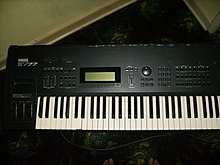Yamaha SY77
| SY77 | |
|---|---|
 |
|
| Manufacturer | Yamaha |
| Dates | (Japan) December 1, 1989 |
| Price | (Japan) ¥300,000 |
| Technical specifications | |
| Polyphony | 32 (16 AFM layers, 16 AWM layers), shared between up to 16 voices |
| Timbrality | 16 voices, each containing up to 2 AFM layers and 2 AWM layers |
| Oscillator | sine wave and 15 harmonically enhanced variants thereof |
| LFO | sine, sawtooths, triangle, sample-and-hold; can control pitch, amplitude, cutoff, etc. |
| Synthesis type | Digital Frequency modulation, Digital Sample-based |
| Filter | lowpass (12 dB or 24 dB), highpass, or multi-pole |
| Storage memory | 64 custom patches can be stored in battery-powered onboard RAM |
| Effects | 2 reverb units (40 effect types) and 2 modulation units (4 effect types) |
| Input/output | |
| Keyboard | 61 keys with velocity sensitivity and aftertouch |
| Left-hand control | Pitch-bend, 2 modulation wheel |
| External control | MIDI |
Yamaha SY77 is a 16 voice multitimbral music workstation first produced by Yamaha Corporation in 1989. The SY77 is a synthesizer whose architecture combines AFM (Advanced Frequency Modulation) synthesis, AWM2 (Advanced Wave Memory 2) for ROM-borne sample-based synthesis, and the combination of these two methods christened Realtime Convolution and Modulation Synthesis (RCM). The same technology was also packaged in a rack-mounted module released simultaneously, the TG77.
The SY77 is equipped with a 61-key keyboard with velocity and aftertouch; has a pitch wheel and two modulation wheels (the latter being quite a rare feature among keyboards in general); and has a large backlit LCD display, expansion slots, floppy-drive, on-board effects, and a 16,000 note sequencer. Programming is performed through a keypad on the front panel.
When the SY77 was released in late 1989, its initial prices were close to $3000 USD/£2000 GBP. In 1991, it was followed by the SY99, a successor that cost ~$4000/£3000 and expanded its capabilities with a 76-key keyboard, the ability to load user-specified samples for AWM, a more advanced effects unit, and other features.
The AFM synthesis of the SY77 is effectively a superset of the 6-operator FM synthesis available on the Yamaha DX7 and DX7 II series of synthesizers. It is capable of all of the sounds that can be produced by those earlier keyboards – with various programs being able to automatically translate DX patches intelligently into accurate SY equivalents – and many more sounds besides. Among the advantages of AFM synthesis over FM synthesis are: a larger choice of algorithms, 15 additional waves besides the standard sine, which have additional harmonic content; 45 standard algorithms instead of the DX7's 32, plus a new ability to design one's own custom-routed algorithm using MIDI/SysEx; the flexible routing of up to three feedback sources within any algorithm, as opposed to the DX series' fixed algorithms with a single source each; the ability to route the FM signal through a configurable filter with the options of resonance and self-oscillation; and more.
The SY/TG series also features Yamaha's now-flagship Advanced Wave Memory 2 (AWM2) technology for playback and manipulation of PCM samples, an evolution of the AWM included earlier in their TX16W. Such waveforms can be used as samples alone; can be layered with FM-based Elements, including using them as transients to FM-synthesized main waveforms, similarly to Roland's LA synthesis; or, in a feature unique to the SY/TG series, can be used as modulators for FM operators in place of elementary signals like the sine wave.
...
Wikipedia
